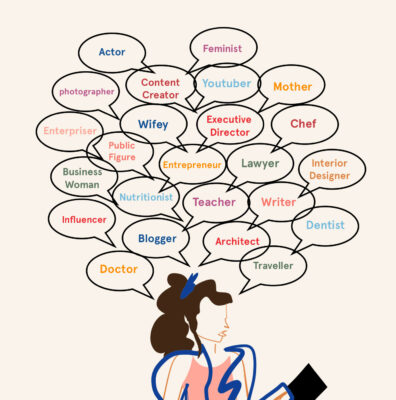 Tina was at a crossroads. Her daughter had recently left for college, and her husband had his own pursuits. And although she’d once enjoyed banking, she now bore little interest in her work. For some time, she had been asking herself whether she should quit. But what would her colleagues and bosses think of her?
Tina was at a crossroads. Her daughter had recently left for college, and her husband had his own pursuits. And although she’d once enjoyed banking, she now bore little interest in her work. For some time, she had been asking herself whether she should quit. But what would her colleagues and bosses think of her?
This stream of consciousness carried Tina to deeper, more revealing questions. What if all her choices had been in response to what others expected? She had always been her parents’ golden child – a star student who married a man they approved of and went into the same industry her father and grandfather had pursued. Now, at the age of 45, she was wondering if these choices were really pseudo-choices, given the pressure her family had put on her? And even more frightening: what other choices did she have at this point in her life?
Tina increasingly began to question herself. Where was all of this coming from? Was there a hidden part of herself she didn’t understand – or maybe even know about? She remembered how as an adolescent she had always been preoccupied with: “What do people want me to do? And who do they want me to be?” Perhaps, the time had come to revisit these questions—to take an honest look at what she really wanted to do, not what others expected her to do. But what did the “True Tina” really want?
 The idea of a “true self” and a “false” or “shadow” self has long preoccupied psychologists. For example, Carl Jung introduced the notion of the shadow side of our personality. He viewed “the shadow” as our unknown, dark side—made up of the primitive, negative, socially depreciated human emotions such as sexuality, striving for power, selfishness, greed, envy, jealousy, and anger. But although the shadow personifies everything that we fear, and therefore refuse to acknowledge, it remains a part of us. Jung believed that unless we come to terms with our shadow side, we are condemned to become its unwitting victim.
The idea of a “true self” and a “false” or “shadow” self has long preoccupied psychologists. For example, Carl Jung introduced the notion of the shadow side of our personality. He viewed “the shadow” as our unknown, dark side—made up of the primitive, negative, socially depreciated human emotions such as sexuality, striving for power, selfishness, greed, envy, jealousy, and anger. But although the shadow personifies everything that we fear, and therefore refuse to acknowledge, it remains a part of us. Jung believed that unless we come to terms with our shadow side, we are condemned to become its unwitting victim.
Similarly, Erik Erikson, another famous psychologist, introduced the idea of the identity crisis. Erikson, like Jung, suggests that identity formation has its dark and negative side. There are parts of us that are attractive but disturbing and therefore tend to be submerged. In the process of becoming an adult, we not only internalize what’s viewed as acceptable, we also internalize (be it only subliminally) parental and societal attitudes about undesirable qualities and characteristics. For many of us, these “undesirables” turn into “forbidden fruits”–things we are attracted to. To feel more authentic, we may have to integrate these forbidden fruits into our sense of identity.
Donald Winnicott elaborated on the idea of the “true self” and “false self.” He explained that beginning in infancy, all of us, in response to perceived threats to our well-being, develop a defensive structure that may evolve into a “false self.” He suggests that if our basic needs are not acknowledged—not mirrored back to us by our parents—we may presume they are unimportant. Complying with our parents’ desires, we may repress our own desires, not actualizing what we really like to do. We may believe that non-compliance endangers our role in the family. In addition, we may internalize our parents’ dreams of self-glorification through our achievements. But this acquiescence to the wishes of others is an emotional lie. It comes at the price of suppressing our own needs. In our efforts to please others, we hide and deny our “true self,” which in turn leads to self-estrangement. If that’s the case, the “false self” will get the upper hand. It becomes a defensive armor to keep the “true self” at bay and hidden.
 If there is too great a discrepancy between the “true” and the “false” self, it will make for a vulnerable sense of identity. And if we are unable to acquire a stable sense of identity—we may end up one day unraveling as Tina did. After a lifetime of complying to others’ expectations, Tina was experiencing what Erikson would call a delayed identity crisis. At a certain point in her life, it became difficult for her keep up the lie.
If there is too great a discrepancy between the “true” and the “false” self, it will make for a vulnerable sense of identity. And if we are unable to acquire a stable sense of identity—we may end up one day unraveling as Tina did. After a lifetime of complying to others’ expectations, Tina was experiencing what Erikson would call a delayed identity crisis. At a certain point in her life, it became difficult for her keep up the lie.
What Tina’s case also illustrates is that the journey of identity exploration that often begins at adolescence doesn’t stop there. In her case, the tension between “false self” and “true self” came to a head, contributing to a renewal of the confusion she had experienced at an earlier stage of life. Not living a full, complete life—not integrating these other parts of herself, call it her shadow or negative identity—turned out to be extremely draining, contributing to life choices that didn’t accommodate her real needs. Ignoring her shadow side was taking an enormous amount of energy, depleting her of her inner creativity, and contributed to various stress symptoms, including depressive reactions.
But the “return of the repressed” should not be looked at as a purely negative experience. Although a person might view these parts of herself as a representation of her unlived life, a delayed identity crisis can also contain the seeds of psychological renewal—the motivation to enter new directions in life. Romancing your shadow—accepting these unlived parts of yourself and learning to read the messages that are contained in it—can lead to a deeper level of consciousness, as well as spark your imagination. When a person is ready to accept these parts—and not try to push them aside — she or he may discover all sorts of creative, positive ideas begging for fulfillment. These buried desires will help them to reflect not only on the question of “Who am I?” but also “Who do I want to be?” This can turn a negative spiral of self-pity turned into the opposite.
That’s what happened in Tina’s case. She came to grips with her previous life experiences. She captured her dreams in a journal, and wrote about the associations that came to her. She wrote letters to her past and future self. She told her husband about her dreams and the emotions they evoked. Together, they talked about her feelings of frustration and anxiety. Her husband began sharing some of his dreams with her, as well. Their conversations eventually took a more concrete turn, as they discussed their future together, including their careers, finances, and upcoming life choices. Her self-exploration gave her greater awareness both of her inner theatre and what her life journey had been up till this moment.
Reassured and invigorated, Tina took a hard look at her work responsibilities and saw ways that she could make changes that would benefit the bank as well as herself. She even got into an argument with her father at the dinner table about politics, and to her great surprise, he seemed to respect her opinion.
Most of us find this difficult, confusing work, as Tina did. But learning to sort out our inner demons can be liberating. Questioning, reflecting, and having meaningful conversations with important people in our lives can help us come to terms with our shadow sides and create the rapprochement needed between our “false” and “true” selves. To do this, we have to figure out how to accept what we learn about ourselves without judgment. And to do that, we must approach self-knowledge with curiosity, as if it were a fascinating adventure – an exploration of the riches contained in this previously unknown world inside the self.
Original article here



 About 20 years ago, working for National Geographic, and with a grant from the National Institute on Aging, I started identifying and studying the longest-lived people, those who are in what we called the world’s Blue Zones. These are people who have eluded heart disease, diabetes, dementia, and several types of cancer.
About 20 years ago, working for National Geographic, and with a grant from the National Institute on Aging, I started identifying and studying the longest-lived people, those who are in what we called the world’s Blue Zones. These are people who have eluded heart disease, diabetes, dementia, and several types of cancer.